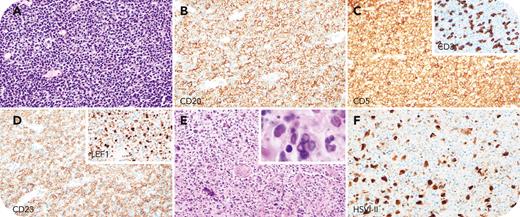A 75-year-old man with a history of treatment-naïve chronic lymphocytic leukemia/small lymphocytic lymphoma (CLL/SLL) presented with enlarging left retroperitoneal and inguinal lymphadenopathy clinically suspicious for transformation to a higher grade lymphoma (Richter transformation). Needle core biopsy of an inguinal lymph node showed effacement of the nodal architecture by a diffuse infiltrate of small, mature lymphocytes (panel A, hematoxylin and eosin [H&E] stain) expressing CD20 (panel B), CD5 (panel C, compare with CD3+ T cells in inset), CD23 (panel D), and lymphoid enhancer-binding factor-1 (panel D inset) (original magnification ×40 for panels A-D), indicating persistent CLL/SLL. No Richter transformation was identified. A separate fragment showed suppurative necrosis (panel E, original magnification ×40, H&E stain) with cells showing degenerating nuclei with a ground glass appearance, chromatin margination, and multinucleation (panel E inset, original magnification ×100), characteristic of herpes simplex virus (HSV) infection. Immunostaining for HSV-1 and -2 confirmed the diagnosis of herpetic lymphadenitis (panel F, original magnification ×40).
Herpetic lymphadenitis is an uncommon cause of rapidly enlarging lymphadenopathy in patients with SLL/CLL, mimicking the much more frequent Richter transformation. The presence of suppurative necrosis (containing neutrophils, as opposed to tumor necrosis) is a clue and should trigger a careful search for HSV-associated cytopathic viral effects. Good responses to acyclovir/valacyclovir have been seen in the few reported cases.
For additional images, visit the ASH Image Bank, a reference and teaching tool that is continually updated with new atlas and case study images. For more information, visit https://imagebank.hematology.org.


